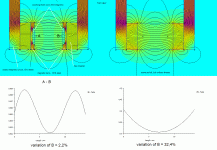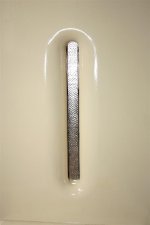Hey,
Do you have gaps at the left, but no steel?
What if you simulate the classic way to do it, with neo on steel, no gaps, all the way up?
What is your point having gaps?
I have done it that way, with a magnetic high at 185cm, and a gap between neo rails at 2,1 cm. There is no problem playing loud! 🙂
Cheers Jan Jensen
I can see two potential problems with a design like yours:
1) I made a FEMM simulation of a 185 cm high ribbon with a 2.1 cm gap (neo magnets and steel are 1.5 cm thick): computed magnetic field in the middle of the ribbon gap : 0.056 T. With a height of 20 cm (everything else equal), the FEMM computed magnetic field is 0.45 T.
2) I built two 20 cm high ribbon systems, one with a 1.3 cm gap and one with a 2.2 cm gap. The 2.2 cm one is about 3 db less sensitive than the 1.3 cm. So, for a 20 cm high ribbon, a wider ribbon decreases sensitivity. I suspect that this would also be the case for a longer one.
Bruno
If you would have field strength measurements to share, that would be very interesting.....
I'm playing with one that has a 4.4 cm width( midrange unit ) and the field strength and efficiency is much reduced over a 2 cm.
How to properly calculate ribbon SPL
SPL calculator posted earlier in this thread (few years ago, I think) shows garbage, so I decided to make my own. All equations taken from "Ribbon Loudspeakers" by Justus Verhagen. Checked with at least 6 commercial ribbon speakers, fits well. I hope it would prove useful. Enjoy 🙂
SPL calculator posted earlier in this thread (few years ago, I think) shows garbage, so I decided to make my own. All equations taken from "Ribbon Loudspeakers" by Justus Verhagen. Checked with at least 6 commercial ribbon speakers, fits well. I hope it would prove useful. Enjoy 🙂
Attachments
SPL calculator posted earlier in this thread (few years ago, I think) shows garbage, so I decided to make my own. All equations taken from "Ribbon Loudspeakers" by Justus Verhagen. Checked with at least 6 commercial ribbon speakers, fits well. I hope it would prove useful. Enjoy 🙂
Very nice. Thanks.
Increasing the B by a factor 2: + 6db sensitivity
Decreasing the ribbon thickness by a factor 2: + 3 db sensitivity
I simulated blaaberg's ribbon using a predicted B of 0.056 (FEMM) as described in my post above.
Ribbon length = 185 cm, width = 2.1 cm , thickness = 10 um, B= 0.056:
95.9 db sensitivity
Ribbon length = 20cm, width = 2.1 cm , thickness = 10 um, B= 0.45:
104.1 db sensitivity
This prediction shows that the smaller ribbon is more sensitive than the longer one.
Brunob, can you explain that difference in the value of B? If all physical dimensions are equal (magnets, steel bars, gap), it's impossible to get 8 times lower B for longer ribbon.
What do you guys think about using magnetic lenses? I've tried that and result are better than expected. Homogeneous magnetic field enables using flat ribbon and that has obvious advantages over the corrugated ribbon - higher sensitivity and lower THD (proved by real life experiments performed by Verhagen and described in his book).
What do you guys think about using magnetic lenses? I've tried that and result are better than expected. Homogeneous magnetic field enables using flat ribbon and that has obvious advantages over the corrugated ribbon - higher sensitivity and lower THD (proved by real life experiments performed by Verhagen and described in his book).
Very nice. Thanks.
Increasing the B by a factor 2: + 6db sensitivity
Decreasing the ribbon thickness by a factor 2: + 3 db sensitivity
I simulated blaaberg's ribbon using a predicted B of 0.056 (FEMM) as described in my post above.
Ribbon length = 185 cm, width = 2.1 cm , thickness = 10 um, B= 0.056:
95.9 db sensitivity
Ribbon length = 20cm, width = 2.1 cm , thickness = 10 um, B= 0.45:
104.1 db sensitivity
This prediction shows that the smaller ribbon is more sensitive than the longer one.
Are you saying multiple small units have higher sensitivity than one large one ?
hhf_pm: What do you mean by magnetic lenses ?
The FEMM simulation shows that the magnetic field decreases with the length of the ribbon. I can not check if this is true since I don't have a gauss meter. See post n. 581 (http://www.diyaudio.com/forums/planars-exotics/50162-another-diy-ribbon-thread-59.html#post2208504)Brunob, can you explain that difference in the value of B? If all physical dimensions are equal (magnets, steel bars, gap), it's impossible to get 8 times lower B for longer ribbon.
Corrugated ribbon have lower THD at low frequency and higher THD at high frequency. I have seen this in the German magazine Hobby-HifiWhat do you guys think about using magnetic lenses? I've tried that and result are better than expected. Homogeneous magnetic field enables using flat ribbon and that has obvious advantages over the corrugated ribbon - higher sensitivity and lower THD (proved by real life experiments performed by Verhagen and described in his book).
It's true if magnetic field isn't homogeneous (90% of commercial speakers). Lower frequencies require higher excursion, so if the magnetic field isn't homogeneous, THD will increase with decreasing frequency. Magnetic lenses in magnetic circuit can greatly lower THD at low frequencies with uncorrugated ribbon, so ths way (magnetic lenses + flat ribbon) we get THD lowered in entire band of the speaker - that's what I'm trying to achieve.
Member
Joined 2003
The FEMM simulation shows that the magnetic field decreases with the length of the ribbon. I can not check if this is true since I don't have a gauss meter. See post n. 581 (http://www.diyaudio.com/forums/planars-exotics/50162-another-diy-ribbon-thread-59.html#post2208504)
Perhaps because the view of the gap is from the outside (surface) instead of top down view (cross-section).
The FEMM simulation shows that the magnetic field decreases with the length of the ribbon. I can not check if this is true since I don't have a gauss meter. See post n. 581 (http://www.diyaudio.com/forums/planars-exotics/50162-another-diy-ribbon-thread-59.html#post2208504)
My gauss meter did not reflect such at the time my ribbon is 150 Cm...
Corrugated ribbon have lower THD at low frequency and higher THD at high frequency. I have seen this in the German magazine Hobby-Hifi
True.... Dat ....
Working planar .............. 😛
Ribbon...and now its playing 🙂
Connected through old Gamma trafo
1. try with 1uf series cap, sounded VERY subtle
2. try with 2.2uf, a bit more sound
Finally with 10uf cap it plays louder
quite smooth and detailed, "airy" and soft, easy on the ears
After its disconnected again, it could sound like it may have played louder than I first thought
Suddenly it becomes obvious what I have been missing for way too long
But at the moment I have no speaker that it could be implemented into, its just experimental right now
I have a pair of Betsy, and a Lowther horn, so maybe that will work, just lack of free time
try it as a supertweeter......
for that it would be better to build them much much smaller, with very narrow field gap 😉
anyway, I etimate sensitivity to be around 90db, or so
Thats too bad 90db is not gonna work with a Lowther.
yeah now that I look at the photo closer it is a little big for that.
Somebody gosh I forgot who now but they make a little ribbon super tweeter That is somewhere around 96db or maybe 98db ,one of the audio rags did a review couple years ago onit.
yeah now that I look at the photo closer it is a little big for that.
Somebody gosh I forgot who now but they make a little ribbon super tweeter That is somewhere around 96db or maybe 98db ,one of the audio rags did a review couple years ago onit.
yeah now that I look at the photo closer it is a little big for that.
ribbon diaphragm itself is 170mm long, 12mm wide
cheap sandwich "paper"
paper on one side, foil on the other
corrugating is easy
place diaphragm on a fine cloth, and roll a piece of hard flag line back and forth
smaller is lighther
and narrow gap gets much stronger
but I wouldnt make it VERY short
efficiency is also about size
its a balance act
but its possible to get long 3" magnet
could be fun
and VERY dangerous
I guess a 90mm x 8mm ribbon diaphragm would work
very expencive magnets
but with only 4 needed, no problem
my magnets are relatively small/thin
just some I got for free, a long time ago
They more or less determined the size of this one
and trafos are as said from burned Gamma's(Decca copy), of which there have been plenty, burned ones
these trafos are not much bigger than the tip of a thumb
and poorly assembled in wax
but one side(primary?) is soft silver plate
I suppose thats worth something
I am thinking about having quality trafos made by trafo specialist
I think its worth it
I have made about 6 pairs of ribbons over the years .
I usually use the foil from an unwound film capacitor, it is quite thin and makes for a fairly efficent speaker albeit low impedance .
I had apair of 4 foot tall ones about 10 years ago that sounded quite good
which I ran directly from a hafler DH220 with an active crossover .
these used several hundred cheap ceramic magnets but had a very powerfull field .
the transformers for a tweeter are kind of a problem though unless you are willing to wind them yourself. seems like there was a guy that was selling Decca replacements, out of England If I remember right. seems like his name was Dawson. I don't know if he is still around.
I usually use the foil from an unwound film capacitor, it is quite thin and makes for a fairly efficent speaker albeit low impedance .
I had apair of 4 foot tall ones about 10 years ago that sounded quite good
which I ran directly from a hafler DH220 with an active crossover .
these used several hundred cheap ceramic magnets but had a very powerfull field .
the transformers for a tweeter are kind of a problem though unless you are willing to wind them yourself. seems like there was a guy that was selling Decca replacements, out of England If I remember right. seems like his name was Dawson. I don't know if he is still around.
Could you provide more details about the sandwich paper (brand, ...)?ribbon diaphragm itself is 170mm long, 12mm wide
cheap sandwich "paper"
paper on one side, foil on the other
corrugating is easy
place diaphragm on a fine cloth, and roll a piece of hard flag line back and forth
Did you remove the paper from the foil?
Thanks for sharing,
Bruno
- Home
- Loudspeakers
- Planars & Exotics
- Another DIY Ribbon thread


